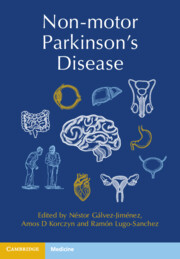Book contents
- Non-Motor Parkinson’s Disease
- Non-Motor Parkinson’s Disease
- Copyright page
- Contents
- Contributors
- Introduction
- Chapter 1 Parkinson’s Disease: An Overview of the Non-Motor Symptomatology
- Chapter 2 Evaluation of the Patient with Parkinson’s Disease in the Early Stages: Non-Motor Phase
- Chapter 3 Non-Motor Symptoms in Late-Stage Parkinson’s Disease
- Chapter 4 Neuropathology of Non-Motor Parkinson’s Disease Symptoms
- Chapter 5 Neuroimaging Studies in Non-Motor Parkinson’s Disease Symptoms
- Chapter 6 Mild Cognitive Impairment
- Chapter 7 Cognitive Dysfunction in Parkinson’s Disease
- Chapter 8 Neuropsychiatric (Behavioral) Symptoms in Parkinson’s Disease
- Chapter 9 Mood Disorders in Parkinson’s Disease
- Chapter 10 Olfactory Dysfunction in Parkinson’s Disease and Related Disorders
- Chapter 11 Oculomotor and Visual-Vestibular Disturbances in Parkinson’s Disease
- Chapter 12 Autonomic Dysfunction and Failure in Parkinson’s Disease
- Chapter 13 Gastrointestinal Disturbances in Parkinson’s Disease Including the Management of Sialorrhea
- Chapter 14 Sexual Dysfunction in Parkinson’s Disease
- Chapter 15 Sleep Disturbances in Parkinson’s Disease
- Chapter 16 Musculoskeletal Disorders and Pain in Parkinson’s Disease
- Chapter 17 Cutaneous Manifestations of Parkinson’s Disease
- Chapter 18 Genetics of Non-Motor Symptoms of Parkinson’s Disease
- Chapter 19 Drug-Induced Non-Motor Symptoms in Parkinson’s Disease
- Chapter 20 Impulse Control Disorders and the Dopamine Dysregulation Syndrome
- Chapter 21 Serotonin Syndrome and Drug Interactions, Hypertensive Complications, and, Adverse Effects of Monoamine Oxidase Inhibitors in Patients with Parkinson’s Disease
- Chapter 22 Parkinson’s Disease and Pregnancy
- Index
- Plate Section (PDF Only)
- References
Chapter 18 - Genetics of Non-Motor Symptoms of Parkinson’s Disease
Published online by Cambridge University Press: 05 March 2022
- Non-Motor Parkinson’s Disease
- Non-Motor Parkinson’s Disease
- Copyright page
- Contents
- Contributors
- Introduction
- Chapter 1 Parkinson’s Disease: An Overview of the Non-Motor Symptomatology
- Chapter 2 Evaluation of the Patient with Parkinson’s Disease in the Early Stages: Non-Motor Phase
- Chapter 3 Non-Motor Symptoms in Late-Stage Parkinson’s Disease
- Chapter 4 Neuropathology of Non-Motor Parkinson’s Disease Symptoms
- Chapter 5 Neuroimaging Studies in Non-Motor Parkinson’s Disease Symptoms
- Chapter 6 Mild Cognitive Impairment
- Chapter 7 Cognitive Dysfunction in Parkinson’s Disease
- Chapter 8 Neuropsychiatric (Behavioral) Symptoms in Parkinson’s Disease
- Chapter 9 Mood Disorders in Parkinson’s Disease
- Chapter 10 Olfactory Dysfunction in Parkinson’s Disease and Related Disorders
- Chapter 11 Oculomotor and Visual-Vestibular Disturbances in Parkinson’s Disease
- Chapter 12 Autonomic Dysfunction and Failure in Parkinson’s Disease
- Chapter 13 Gastrointestinal Disturbances in Parkinson’s Disease Including the Management of Sialorrhea
- Chapter 14 Sexual Dysfunction in Parkinson’s Disease
- Chapter 15 Sleep Disturbances in Parkinson’s Disease
- Chapter 16 Musculoskeletal Disorders and Pain in Parkinson’s Disease
- Chapter 17 Cutaneous Manifestations of Parkinson’s Disease
- Chapter 18 Genetics of Non-Motor Symptoms of Parkinson’s Disease
- Chapter 19 Drug-Induced Non-Motor Symptoms in Parkinson’s Disease
- Chapter 20 Impulse Control Disorders and the Dopamine Dysregulation Syndrome
- Chapter 21 Serotonin Syndrome and Drug Interactions, Hypertensive Complications, and, Adverse Effects of Monoamine Oxidase Inhibitors in Patients with Parkinson’s Disease
- Chapter 22 Parkinson’s Disease and Pregnancy
- Index
- Plate Section (PDF Only)
- References
Summary
Parkinson’s disease (PD) has long been considered as a prototype of a sporadic disorder with little or no involvement of genetic factors. Three to four decades ago, the typical perception of genetics in PD was that “it appears unlikely that heredity is an important determinant in the development of the disorder” [1]. The discovery of SNCA mutations in 1997 [2] started a new era of genetic studies in PD. We now know of at least 90 independent genome-wide association study (GWAS) risk variants in 78 loci that are associated with sporadic PD [3]. Several other genes that are involved in familial, sporadic PD, or atypical forms of familial parkinsonism, have also been identified (Table 18.1).
- Type
- Chapter
- Information
- Non-motor Parkinson's Disease , pp. 199 - 211Publisher: Cambridge University PressPrint publication year: 2022



